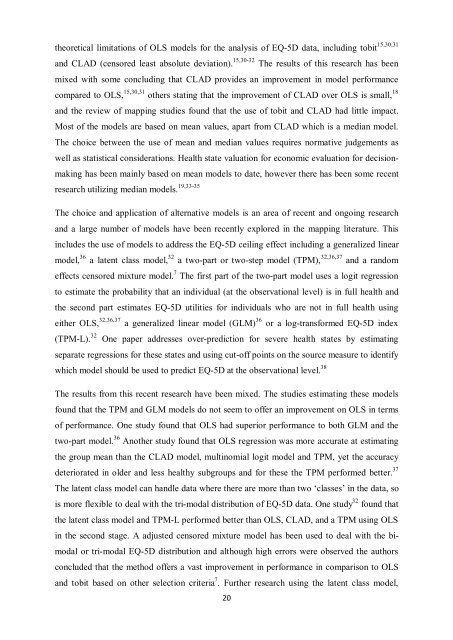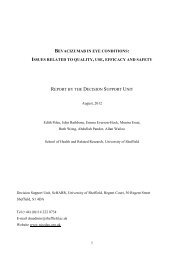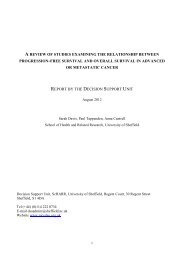the use of mapping methods to estimate health state utility values
the use of mapping methods to estimate health state utility values
the use of mapping methods to estimate health state utility values
Create successful ePaper yourself
Turn your PDF publications into a flip-book with our unique Google optimized e-Paper software.
<strong>the</strong>oretical limitations <strong>of</strong> OLS models for <strong>the</strong> analysis <strong>of</strong> EQ-5D data, including <strong>to</strong>bit 15,30,31<br />
and CLAD (censored least absolute deviation). 15,30-32 The results <strong>of</strong> this research has been<br />
mixed with some concluding that CLAD provides an improvement in model performance<br />
compared <strong>to</strong> OLS, 15,30,31 o<strong>the</strong>rs stating that <strong>the</strong> improvement <strong>of</strong> CLAD over OLS is small, 18<br />
and <strong>the</strong> review <strong>of</strong> <strong>mapping</strong> studies found that <strong>the</strong> <strong>use</strong> <strong>of</strong> <strong>to</strong>bit and CLAD had little impact.<br />
Most <strong>of</strong> <strong>the</strong> models are based on mean <strong>values</strong>, apart from CLAD which is a median model.<br />
The choice between <strong>the</strong> <strong>use</strong> <strong>of</strong> mean and median <strong>values</strong> requires normative judgements as<br />
well as statistical considerations. Health <strong>state</strong> valuation for economic evaluation for decisionmaking<br />
has been mainly based on mean models <strong>to</strong> date, however <strong>the</strong>re has been some recent<br />
research utilizing median models. 19,33-35<br />
The choice and application <strong>of</strong> alternative models is an area <strong>of</strong> recent and ongoing research<br />
and a large number <strong>of</strong> models have been recently explored in <strong>the</strong> <strong>mapping</strong> literature. This<br />
includes <strong>the</strong> <strong>use</strong> <strong>of</strong> models <strong>to</strong> address <strong>the</strong> EQ-5D ceiling effect including a generalized linear<br />
model, 36 a latent class model, 32 a two-part or two-step model (TPM), 32,36,37 and a random<br />
effects censored mixture model. 7 The first part <strong>of</strong> <strong>the</strong> two-part model <strong>use</strong>s a logit regression<br />
<strong>to</strong> <strong>estimate</strong> <strong>the</strong> probability that an individual (at <strong>the</strong> observational level) is in full <strong>health</strong> and<br />
<strong>the</strong> second part <strong>estimate</strong>s EQ-5D utilities for individuals who are not in full <strong>health</strong> using<br />
ei<strong>the</strong>r OLS, 32,36,37 a generalized linear model (GLM) 36 or a log-transformed EQ-5D index<br />
(TPM-L). 32 One paper addresses over-prediction for severe <strong>health</strong> <strong>state</strong>s by estimating<br />
separate regressions for <strong>the</strong>se <strong>state</strong>s and using cut-<strong>of</strong>f points on <strong>the</strong> source measure <strong>to</strong> identify<br />
which model should be <strong>use</strong>d <strong>to</strong> predict EQ-5D at <strong>the</strong> observational level. 38<br />
The results from this recent research have been mixed. The studies estimating <strong>the</strong>se models<br />
found that <strong>the</strong> TPM and GLM models do not seem <strong>to</strong> <strong>of</strong>fer an improvement on OLS in terms<br />
<strong>of</strong> performance. One study found that OLS had superior performance <strong>to</strong> both GLM and <strong>the</strong><br />
two-part model. 36 Ano<strong>the</strong>r study found that OLS regression was more accurate at estimating<br />
<strong>the</strong> group mean than <strong>the</strong> CLAD model, multinomial logit model and TPM, yet <strong>the</strong> accuracy<br />
deteriorated in older and less <strong>health</strong>y subgroups and for <strong>the</strong>se <strong>the</strong> TPM performed better. 37<br />
The latent class model can handle data where <strong>the</strong>re are more than two ‘classes’ in <strong>the</strong> data, so<br />
is more flexible <strong>to</strong> deal with <strong>the</strong> tri-modal distribution <strong>of</strong> EQ-5D data. One study 32 found that<br />
<strong>the</strong> latent class model and TPM-L performed better than OLS, CLAD, and a TPM using OLS<br />
in <strong>the</strong> second stage. A adjusted censored mixture model has been <strong>use</strong>d <strong>to</strong> deal with <strong>the</strong> bimodal<br />
or tri-modal EQ-5D distribution and although high errors were observed <strong>the</strong> authors<br />
concluded that <strong>the</strong> method <strong>of</strong>fers a vast improvement in performance in comparison <strong>to</strong> OLS<br />
and <strong>to</strong>bit based on o<strong>the</strong>r selection criteria 7 . Fur<strong>the</strong>r research using <strong>the</strong> latent class model,<br />
20





